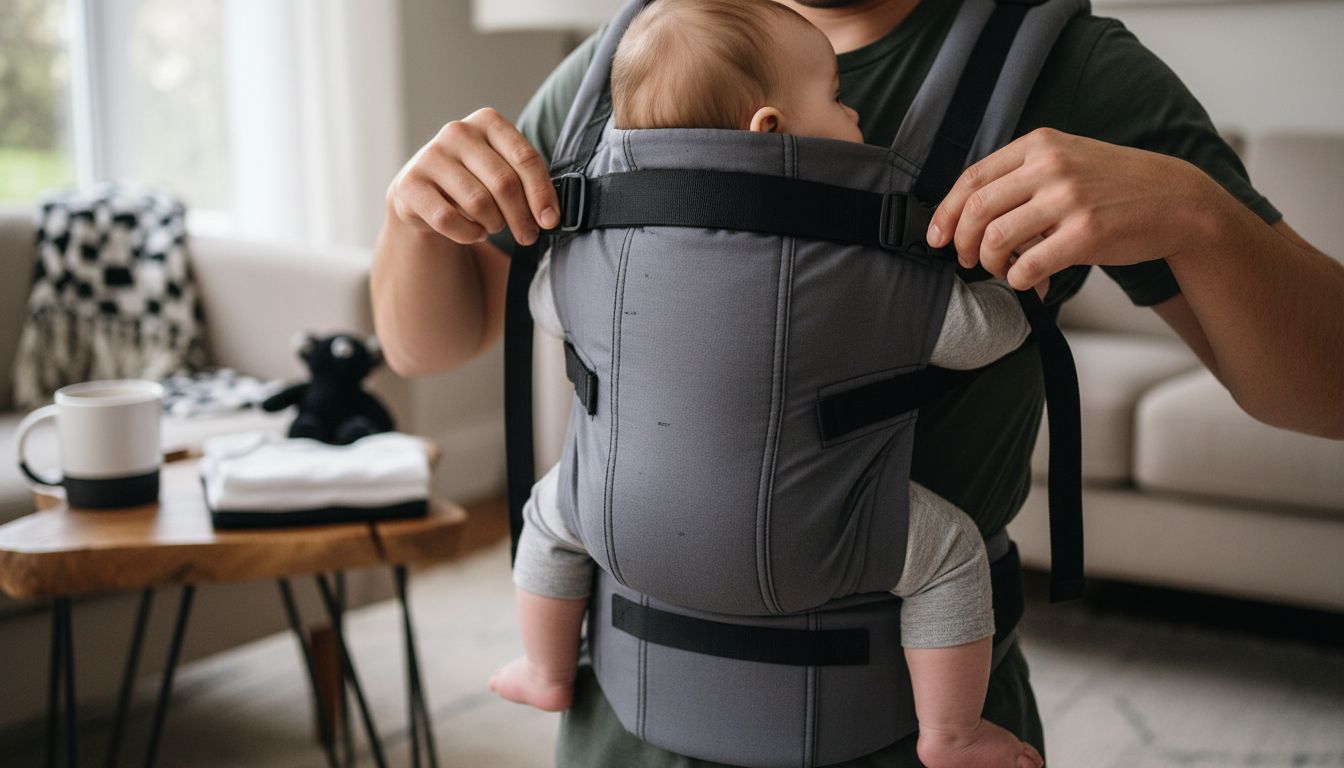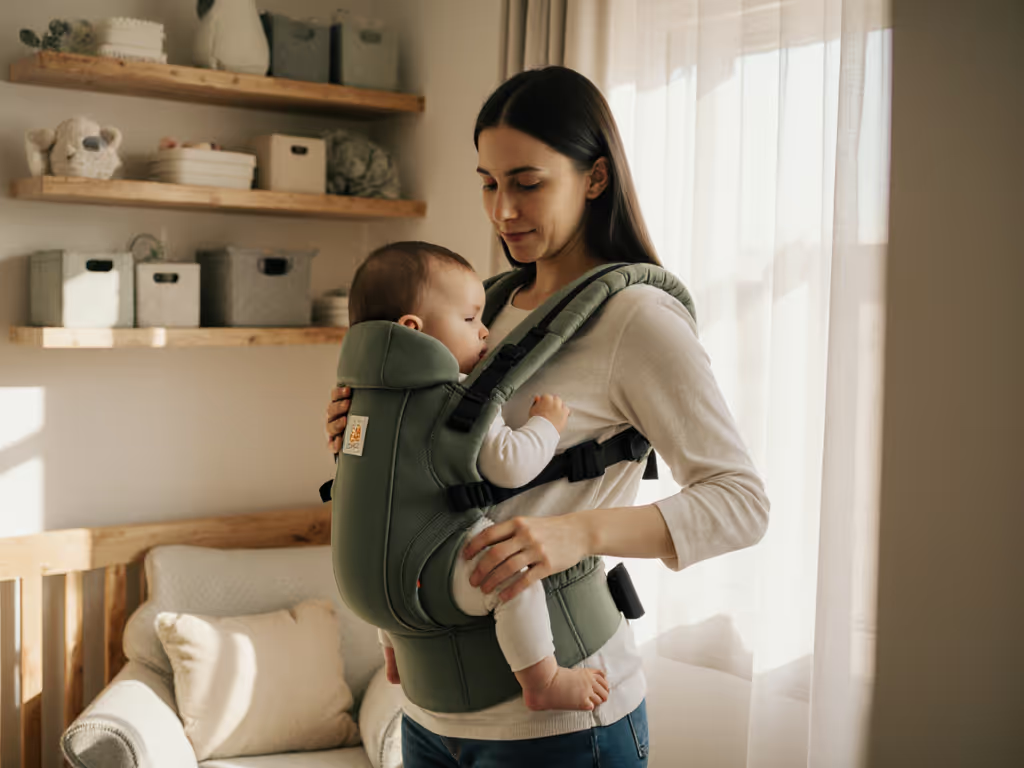
Ergonomics in Babywearing: Complete Caregiver Guide

Did you know that poor babywearing can increase strain on a caregiver's back by as much as 75 percent? Many parents overlook how much proper alignment matters when carrying their little ones. Embracing ergonomic practices not only keeps babies comfortable and supports healthy growth, but also helps caregivers avoid pain and fatigue. With the right approach, babywearing turns into a secure, nurturing experience that benefits both body and bond.
Key Takeaways
| Point | Details |
|---|---|
| Ergonomic Babywearing | Prioritizes caregiver comfort and baby developmental needs through proper positioning and weight distribution. |
| Types of Carriers | Various ergonomic baby carriers (soft-structured, wraps, ring slings, Meh Dai) cater to different needs and preferences for both caregiver and infant. |
| Optimal Infant Positioning | Ensure the baby is in an 'M' position to promote healthy spine and hip development while maintaining airway safety. |
| Common Mistakes | Avoid poor positioning, uneven weight distribution, and neglecting baby comfort to transform babywearing into a nurturing experience. |
Defining Ergonomics in Babywearing Practices
Ergonomics in babywearing represents a specialized approach to carrying infants that prioritizes both the caregiver's physical comfort and the baby's developmental needs. Far more than simply transporting a child, this practice involves strategic positioning that supports natural body mechanics and promotes healthy growth.
At its core, ergonomic babywearing focuses on three critical elements: baby positioning, weight distribution, and physiological alignment. The goal is to create a carrying method that mimics the natural way an infant would be held, ensuring the baby's spine remains in a gentle, curved "C" shape while providing maximum support for their developing musculoskeletal system. This means keeping the baby's hips spread wide, knees higher than their bottom, and maintaining a close, secure connection to the caregiver's body.
For caregivers, an ergonomic approach dramatically reduces physical strain by evenly distributing the baby's weight across the body. This prevents concentrated pressure on specific muscle groups and minimizes the risk of back, shoulder, and neck pain. Key benefits include:
- Reduced musculoskeletal stress
- Enhanced mobility and hands-free movement
- Improved bonding through consistent physical contact
- Support for the baby's natural developmental positioning
Understanding and implementing ergonomic babywearing techniques transforms a simple act of carrying into a supportive, health-conscious practice that benefits both caregiver and child.
Types of Ergonomic Baby Carriers Explained
Ergonomic baby carriers come in several distinct styles, each designed to address unique caregiver needs and infant developmental requirements. Understanding the characteristics of each type helps parents select the most appropriate carrier for their specific lifestyle and comfort preferences.
Soft-structured carriers represent the most versatile option in ergonomic babywearing. These carriers feature padded shoulder straps and waist belts that distribute the baby's weight evenly across the caregiver's body. Typically equipped with adjustable buckles and straps, they accommodate babies from newborn to toddler stages and can be worn on the front, back, or hip. Their structured design provides excellent support while allowing quick transitions between carrying positions.

Alternative carrier types offer different benefits:
- Wraps: Long fabric pieces that create a custom, snug fit by wrapping around the caregiver's body. Ideal for newborns due to their incredibly adaptable nature.
- Ring Slings: Single-shoulder carriers that provide quick, easy positioning and are excellent for short carries.
- Meh Dais: Traditional Asian-style carriers that blend wrap flexibility with structured carrier support, featuring a rectangular body panel and long tie straps.
When choosing an ergonomic carrier, consider factors like your baby's age, your physical comfort, and the activities you'll be performing while babywearing. Each carrier type offers unique advantages, so understanding their specific features will help you make the most informed decision for your family.
Here's a comparison of the key ergonomic baby carrier types and their features:
| Carrier Type | Support Level | Age Range | Key Benefits |
|---|---|---|---|
| Soft-structured | High<br>Padded | Newborn–Toddler | Versatile positions<br>Easy adjust |
| Wrap | Customizable fit | Newborn–Early infant | Snug<br>Adaptable<br>Comforting |
| Ring Sling | Moderate | Newborn–Toddler | Quick use<br>Lightweight<br>Cooler |
| Meh Dai | Balanced | Infant–Toddler | Wrap-like<br>Structured support |
Safe Positioning and Healthy Infant Development
Infant positioning in babywearing is far more than a comfort consideration — it's a critical factor in supporting healthy physical development. The way a baby is carried can significantly impact their musculoskeletal growth, particularly during the crucial early months when their skeletal system is rapidly developing and most vulnerable.
The optimal positioning for infant carriers involves what experts call the "M" or "frog" position. This means the baby's knees should be spread wider than their hips, creating a natural, spread-squat stance that supports proper hip joint development. The spine should maintain its natural curved shape, resembling a gentle "C" rather than being stretched straight. By keeping the baby's bottom lower than their knees and ensuring their back is well-supported, caregivers can help prevent potential hip dysplasia and promote healthy spine alignment.
Key safety considerations for optimal infant positioning include:
- Ensuring the baby's airway remains clear and unobstructed
- Maintaining a position where the baby's head is close enough to kiss
- Supporting the natural curve of the spine
- Keeping knees spread wider than hips
- Preventing the baby's chin from resting on their chest, which can restrict breathing
Careful attention to these positioning details transforms babywearing from a simple transportation method into a developmental support system that nurtures the infant's physical growth and provides a secure, comforting environment.
Ergonomic Benefits for Caregivers and Babies
Ergonomic babywearing creates a symbiotic relationship of physical and emotional benefits for both caregiver and child, transforming a simple act of carrying into a powerful developmental experience. This holistic approach goes beyond mere transportation, offering profound advantages that support physical health and emotional bonding.
For caregivers, the ergonomic benefits are immediately tangible. Properly designed carriers distribute the baby's weight evenly across the body, dramatically reducing strain on the back, shoulders, and neck. This weight distribution allows parents to move freely, maintain better posture, and engage in daily activities while keeping their child close. The hands-free mobility enables multitasking without compromising the baby's safety or comfort, making it an ideal solution for active parents and caregivers.
Babies experience equally significant advantages through ergonomic carrying:
- Enhanced neurological development through consistent physical contact
- Improved vestibular and sensory integration
- Reduced crying and increased emotional security
- Support for natural spine and hip development
- Promotion of early social learning through close interaction
The close physical proximity facilitated by ergonomic carriers creates a unique environment of mutual comfort and connection. By supporting natural body mechanics and promoting secure attachment, this approach represents a holistic strategy that nurtures both the caregiver's physical well-being and the infant's comprehensive developmental needs.
Common Babywearing Mistakes and How to Avoid Them
Babywearing can seem intuitive, but many caregivers unknowingly make critical mistakes that compromise their baby's safety and comfort. Understanding these common pitfalls is the first step toward creating a secure, supportive carrying experience that protects both the infant's developing body and the caregiver's physical well-being.
One of the most prevalent errors is improper carrier positioning that fails to support the baby's natural body mechanics. Incorrect hip and spine alignment can lead to potential developmental issues. Caregivers should ensure the carrier maintains the baby's legs in an "M" position, with knees spread wider than the hips, and supports the natural curved spine. This positioning prevents unnecessary strain and promotes healthy musculoskeletal development.
Critical mistakes to watch for and avoid include:
- Choosing carriers that compress the baby's legs into a narrow, straight position
- Allowing the baby's chin to rest against their chest, which can restrict breathing
- Wearing carriers that do not distribute weight evenly across the caregiver's body
- Failing to adjust straps and buckles for a secure, comfortable fit
- Ignoring the baby's comfort and signs of distress during carrying
Mastering proper babywearing techniques requires patience, practice, and a commitment to learning. By staying informed about potential mistakes and actively working to prevent them, caregivers can transform babywearing from a potential risk into a safe, nurturing experience that supports both infant development and caregiver comfort.
Discover Safe and Comfortable Babywearing Solutions Today
Carrying your baby safely and comfortably is more than a daily task it is a commitment to supporting your child’s healthy development and your own well-being. If you want to avoid common mistakes like poor positioning or back strain and embrace the full benefits of ergonomic babywearing then Caregiver Carry is here to guide you. The site offers detailed guides, step-by-step instructions, and trusted reviews that help you find the right carrier that fits your body type and lifestyle while keeping your baby in the recommended "M" position for spine and hip health.
Take control of your babywearing journey now and enjoy hands-free mobility without worry. Explore comprehensive safety checklists and compare carrier types so you can make confident decisions that protect both you and your baby. Don’t wait until discomfort or doubt hold you back visit Caregiver Carry today and find the perfect ergonomic baby carrier tailored just for you.
Frequently Asked Questions
What is ergonomic babywearing?
Ergonomic babywearing focuses on the caregiver's comfort and the baby's developmental needs by positioning the baby correctly to support natural body mechanics and promote healthy growth.
What are the key benefits of ergonomic baby carriers for the caregiver?
Ergonomic baby carriers help reduce physical strain by evenly distributing the baby's weight, allowing for better posture, enhanced mobility, and hands-free movement while engaging in daily activities.
How should I position my baby in an ergonomic carrier?
The optimal positioning is the 'M' or 'frog' position, where the baby's knees are spread wider than their hips, keeping their spine in a natural curved shape, which supports proper hip and spine development.
What are the different types of ergonomic baby carriers, and how do they compare?
Soft-structured carriers are versatile, wraps offer a customizable fit, ring slings provide quick use, and Meh Dais combine wrap flexibility with structured support. Each type has unique advantages for different needs and preferences.




